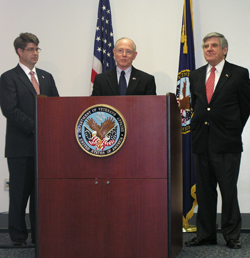 |
Secretary of Veterans Affairs James Peake, M.D., center, talks with the media during a visit to the Omaha VA Medical Center on Monday as U.S. Sen. Ben Nelson, right, and U.S. Rep Lee Terry look on. (Photo by Lisa Ellis, a staff member for U.S. Rep. Lee Terry.) |
The senator’s comment summarized a key message that was delivered to Secretary of Veterans Affairs James Peake, M.D., on Monday — the Omaha VA is delivering quality health care in a building constructed in the 1950s that is now quite outdated and rapidly deteriorating.
Secretary Peake got a first-hand glimpse at some of the Omaha VA’s declining facilities as part of a morning tour and received input from key representatives at UNMC and Creighton University on how the city’s two medical schools work together to deliver quality care to veterans.
“UNMC is fully committed to assisting the Omaha VA in providing world-class health care to veterans in Nebraska and the region,” said UNMC Chancellor Harold M. Maurer, M.D. “We stand ready to help in any way deemed appropriate.”
|
“Our triangle here of UNMC, Creighton and the VA is really unique in the VA system,” said U.S. Rep. Lee Terry, who joined Nelson for the day’s events. “We’re truly blessed in that way. I think that increases the quality of the health care to have the experts — physicians from both UNMC and Creighton actively involved in the VA providing the health care services. We’re unique and it increases the quality of health care that’s delivered at the VA.
“I am focused on one issue, and that’s how do we provide even better services for our men and women who put on the uniform, and frankly the only thing that’s keeping us back from doing that is the structure. Not the people inside of it, but the structure itself. For us to go to the next level in health care, we need a new building.”
Nelson said the Omaha VA’s heating and air conditioning system received a grade of F when it reviewed earlier by VA officials.
“That doesn’t give you an awful lot of confidence in the capabilities of this facility to meet the needs today or tomorrow,” he said. “With Iraq vets coming into the system at a fairly brisk pace, we’re going to have to have this facility in the future be state-of-the-art. We can’t expect people to go to war and come back and not have the kind of care that is necessary.”
The future of the Omaha VA will be determined through a funding system in place at the Department of Veterans Affairs, Secretary Peake said.
“There’s a vetting process that helps us to rack and stack them (other deficient VA medical centers) for viability of the program and then up against the resources that we have, and then each year we wind up making the allocations based on the greatest value with a focus on quality and safety.”
Peake said that ultimately final decisions on which VA medical centers receive funding will be made when the budget is defended in January or February of 2009.
Monday’s visit by Secretary Peake should give the Omaha VA “a higher priority” on the VA funding list, Nelson said.
The Rev. John P. Schlegel, S. J., Creighton’s president, praised the existing partnership between the Omaha VA and the medical schools. He said it allows “our students and faculty the opportunity to work with America’s veterans and help them with their health care needs, which is a critical part of fulfilling our Jesuit university’s mission to contribute to the betterment of society.”
The VA Nebraska-Western Iowa Health Care System serves more than 172,500 veterans in Nebraska, western Iowa and sections of Kansas and Missouri. The Omaha VA Medical Center offers both inpatient and outpatient primary and specialty care services. The system also operates a nursing home care facility in Grand Island, and community-based outpatient clinics in Lincoln, Grand Island, North Platte, Norfolk and Holdrege.